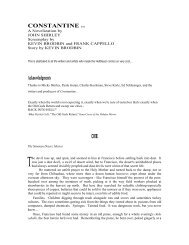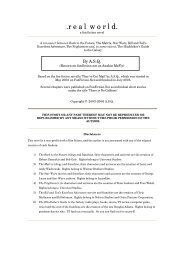Queer Keanu: Race, Sexuality and the Politics of - Whoa is (Not) Me
Queer Keanu: Race, Sexuality and the Politics of - Whoa is (Not) Me
Queer Keanu: Race, Sexuality and the Politics of - Whoa is (Not) Me
You also want an ePaper? Increase the reach of your titles
YUMPU automatically turns print PDFs into web optimized ePapers that Google loves.
Reeves more closely resembles a poststructural<strong>is</strong>t underst<strong>and</strong>ing <strong>of</strong> a self that <strong>is</strong> invented<br />
in relation to prescribed social types. As a result, <strong>the</strong> very notion <strong>of</strong> <strong>the</strong> individual <strong>is</strong> put<br />
into question, <strong>and</strong> ra<strong>the</strong>r than a transcendent core self, we are presented with a self that<br />
shifts, changes, <strong>and</strong> ultimately proves elusive.<br />
Although, Reeves has been able to parlay th<strong>is</strong> destabilized public self into an<br />
extremely successful career, <strong>the</strong> effects <strong>of</strong> h<strong>is</strong> d<strong>is</strong>orienting persona shape both media<br />
pr<strong>of</strong>iles <strong>and</strong> critic<strong>is</strong>m <strong>of</strong> h<strong>is</strong> acting style. Many interviews <strong>and</strong> pr<strong>of</strong>iles begin with <strong>the</strong><br />
caveat that Reeves <strong>is</strong> “as enigmatic <strong>of</strong>fscreen as on” (Robb, 8) or “<strong>Keanu</strong> Reeves has<br />
always had <strong>the</strong> reputation <strong>of</strong> revealing nothing to <strong>the</strong> press. Even those who work with<br />
him find him a tough nut to crack” (F<strong>is</strong>cher). Onscreen Reeves <strong>is</strong> similarly opaque.<br />
Although sexual <strong>and</strong> racial ambiguities pertain most clearly to Reeves “personal” life, <strong>the</strong><br />
problems with articulating a legible self extends to h<strong>is</strong> onscreen work. Mariam Hansen<br />
in her work on Rudolph Valentino argues that for stars neat div<strong>is</strong>ions between real <strong>and</strong><br />
reel life are difficult to maintain. She says:<br />
Because <strong>the</strong> star <strong>is</strong> defined by h<strong>is</strong> or her ex<strong>is</strong>tence outside <strong>of</strong> individual films, by<br />
<strong>the</strong> publicity that surrounds h<strong>is</strong> or her pr<strong>of</strong>essional <strong>and</strong> “private” personality, <strong>the</strong><br />
star’s presence in a particular film blurs <strong>the</strong> boundary between dieges<strong>is</strong> <strong>and</strong><br />
d<strong>is</strong>course, between an address relying on identification with fictional characters<br />
<strong>and</strong> an activation <strong>of</strong> <strong>the</strong> viewer’s familiarity with <strong>the</strong> star on <strong>the</strong> bas<strong>is</strong> <strong>of</strong><br />
production <strong>and</strong> publicity intertexts” (246).













